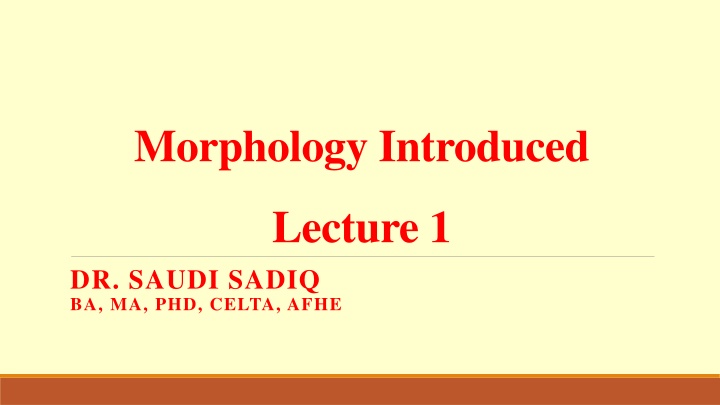
Morphology: A Comprehensive Overview
Explore the nuances of morphology, the study of word structure and formation through morphemes. Learn about morphemes, phonemes, types of morphemes, and the relationship between sound and meaning in language. Gain insights into free and bound morphemes and the various word formation processes. Enhance your understanding of the smallest units of language that carry meaning and contribute to linguistic structure.
Download Presentation

Please find below an Image/Link to download the presentation.
The content on the website is provided AS IS for your information and personal use only. It may not be sold, licensed, or shared on other websites without obtaining consent from the author. If you encounter any issues during the download, it is possible that the publisher has removed the file from their server.
You are allowed to download the files provided on this website for personal or commercial use, subject to the condition that they are used lawfully. All files are the property of their respective owners.
The content on the website is provided AS IS for your information and personal use only. It may not be sold, licensed, or shared on other websites without obtaining consent from the author.
E N D
Presentation Transcript
Morphology Introduced Lecture 1 DR. SAUDI SADIQ BA, MA, PHD, CELTA, AFHE
Defining morphology Differences between morphemes and words Types of morphemes Prefixes and suffixes Prefixes used in English Suffixes used in English Word formation processes: borrowing, calque and blending, abbreviations, acronyms, backformation, compounds Exercises on morphological analysis Differences between morphemes and allomorphs Etymology Final revision Plan
Morpheme Phoneme Differences between Phonemes and Morphemes The smallest grammatical unit of meaning in a language The smallest contrastive unit of the sound in a language As a Word It stands alone as a word It does not stand alone as a word Relation With Meaning and structure Sound and pronunciation Branch of Study Morphology Phonology Derived From French Word Greek Word Types Vowel phonemes, consonant phonemes Free morpheme, bound morpheme
What is Morphology? Morphology: The study of the structure of words & how words are formed (from morphemes) Morpheme: The smallest unit of language that carries meaning (maybe a word or not a word) A sound-meaning unit A minimal unit of meaning or grammatical function The level of language at which sound and meaning combine
More on Morphemes A morpheme is the smallest unit that has a meaning or a grammatical function. For example, the word tour is composed of only one morpheme. But the word tourists is composed of three morphemes as follows: tour is the noun and root of the word ist means 'a person who does something/the tour s which indicates plural.
Types of Morphemes lexical free (open classes) Morphemes functional (closed classes) bound derivational inflectional (affixes) 6
Free and Bound Morphemes Free morphemes can occur by itself, standalone, not attached to other morphemes. Bound morphemes must be attached to another morpheme. 7
